It’s all
rather grim stuff, for more reasons that you may think. At the surface, it’s
easy to empathize: This orca is almost certainly grieving, probably because she
is refusing to accept the death of her newborn. This is a feature observed not
just in a plethora of toothed cetacean species, but throughout the animal
kingdom.
As noted by
Earther, however, there’s a deeper story to all this. It’s unclear what killed
the calf, and scientists intend to retrieve it once the mother lets go to find
out. Nevertheless, it’s likely that this extended family of orcas – the
Southern Resident killer whales, who make offshore British Columbia and
Washington their home – is suffering from nutritional depletion.
These orcas
rely on the presence of Chinook salmon, and, according to the National Oceanic
and Atmospheric Administration (NOAA), two species are listed as endangered
under the Endangered Species Act, while seven others are listed as threatened.
Said threats include habitat degradation and loss, commercial and recreational
overfishing, and everyone’s favorite Big Bad, climate change.
Our marine mammal experts have sighted #KillerWhale J50 and her mother J16 in US waters. J35 is with this pod and is still carrying her calf. We are continuing to work with @NOAAFish_WCRO and other partners to monitor the situation. https://t.co/QUxyv284GG pic.twitter.com/fziQ0JCQc2— DFO Pacific (@DFO_Pacific) August 8, 2018
Those
problems don’t look like they’re going away anytime soon, which means that the
J pod population of orcas don’t exactly have a bright future ahead of them.
A good,
sustainable population number for these whales is around 300, but there are
currently only 75. Pregnancies in this group are failing at an increasing rate,
and there hasn’t been a successful birth in three years.
The funereal
procession itself certainly takes a lot of additional energy, and experts are
already worried about the state of her physical and mental health. Deborah
Giles, research scientist for University of Washington Center for Conservation
Biology and the research director of Wild Orca, told The Seattle Times: “She is
a 20-year-old breeding-age female and we need her.”
The
Committee on the Status of Endangered Wildlife in Canada (COSEWIC) lists the
southern population as “endangered”, stressing that a “variety of anthropogenic
threats” including environmental contamination, the reduction in quality and
quantity of prey, and physical and acoustic disturbances are proving
particularly problematic. All “have the potential to prevent recovery or to
cause further declines.”
Another
young orca, J50, is in bad shape, with its emaciated skull also pointing
towards a lack of food. She's currently being closely monitored by NOAA;
although we're all focused on the plight of J35, J50 appears to be the primary
focus of conservationists at present. Unfortunately, she's ultimately likely to
perish.
J35’s story
is sad, but it’s a microcosm of an accelerating, large-scale disaster – but
it’s not an entirely hopeless situation.
We launched a web page for updates on the response effort to Southern Resident Killer Whales J50 & J35. We will continue to post our latest updates here & on Facebook (NOAA Fisheries West Coast). Learn more & see all updates in one place: https://t.co/N5AmQ4AnOp #J35 #J50 #SRKW pic.twitter.com/086XkXfnpG— NOAAFish_WCRO (@NOAAFish_WCRO) August 6, 2018
As explainedby NOAA, there are certain things people that live in the area can do. If you
wish to help preserve the salmon's habitat, then make sure you conserve both
water and electricity, cut down on your pesticide and fertilizer use if they
are at risk of running off into waterways, and make sure to keep boats away
from the pod.
You can even
volunteer with local groups to remove invasive species and clean up litter if
you have the time – and, as ever, spread the word. When people are armed with
the correct information, it’ll reduce the likelihood of scientists seeing the
likes of this awful procession in the future.

Post A Comment:
0 comments: